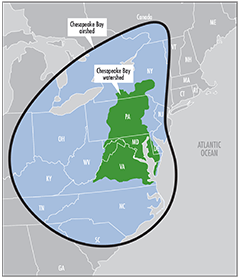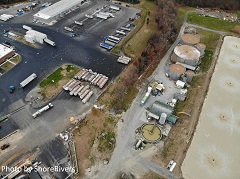Contents
Clean Air Act Challenges Clean Water Act Permit Challenges Hydropower Maryland Critical AreaCLEAN AIR ACT CHALLENGES
Find more information on the types of air pollution impacting the Bay and pollution flowing in from outside the watershed on our Air Pollution web page or watch our video.
EPA’s Federal Good Neighbor Plan for the 2015 Ozone Standards
Updated: 3/20/2025
United States Court of Appeals for the D.C. Circuit
State of Utah, et al. v. United States Environmental Protection Agency
Case No.: 23-1157 (and consolidated cases)
United States Court of Appeals for the D.C. Circuit
National Mining Association, et al. v. United States Environmental Protection Agency
Case No.: 23-1277 (and consolidated cases)
United States Court of Appeals for the D.C. Circuit
U.S. Steel Corp. v. United States Environmental Protection Agency
Case No.: 24-1172 (and consolidated cases)
United States Court of Appeals for the D.C. Circuit
Kinder Morgan, Inc., et al v. United States Environmental Protection Agency
Case No.: 25-1054 (and consolidated cases)
On June 5, 2023, U.S. EPA issued a rule entitled the "Federal 'Good Neighbor Plan' for the 2015 Ozone National Ambient Air Quality Standards" ("Good Neighbor Plan"). The Plan requires 23 upwind states to reduce contributions to ground-level ozone (or smog) pollution by setting limits on nitrogen oxides (NOx) pollution emitted from power plants and other industrial facilities in those states. When NOx is emitted into the air, the gas undergoes a chemical reaction whereby a percentage falls from the air, onto land and water as nitrogen, and some combines with other gases to form ground-level ozone. Ground-level ozone pollution seriously harms public health and the environment.
The Clean Air Act’s "Good Neighbor Provision" requires each state to ensure that its air pollution will not interfere with the National Ambient Air Quality Standards (NAAQS) in downwind or neighboring states. Since NOx pollution travels across state lines, downwind states are burdened by poor air quality caused, in part, by emissions from upwind states, and this interstate pollution interferes with downwind states’ ability to meet the federal ozone standards.
EPA's Plan would reduce nitrogen deposition to the Chesapeake Bay watershed and improve air quality and the health of Bay communities, including those most directly impacted by ozone nonattainment and local sources of pollution. For these reasons, CBF joined a coalition of national environmental and public health groups to intervene, in defense of the Plan, in three separate cases filed by states and industry groups in the D.C. Circuit Court of Appeals.
First, Utah v. EPA in which states and industry groups challenged the Plan itself. Those state and industry petitioners requested a stay of the Plan pending the outcome of the current litigation. CBF and the coalition filed a Motion opposing this request. The Stay request was denied by the D.C. Circuit on October 11, 2023. However, the states and industry groups then filed an Emergency Stay Application with the United States Supreme Court (Ohio, et al v, EPA and consolidated cases). On June 27, 2024, the Court granted the Stay request in a highly unusual decision from its "shadow docket", before full briefing and consideration on the merits. The Supreme Court’s stay order means the Plan and its benefits are currently blocked pending resolution of the D.C. Circuit litigation.
See CBF’s press statement on the Supreme Court’s ruling: Supreme Court Blocks Interstate Smog Pollution Rule, Putting Bay Cleanup and Local Communities at Risk
After the Supreme Court’s decision, the D.C Circuit remanded the administrative record back to EPA to respond to public comments. EPA published a notice in the Federal Register on December 4, 2024 indicating the completion of the remand proceedings. EPA’s response to public comments was then challenged by industry petitioners. CBF moved to intervene in this case (Kinder Morgan v. EPA) on March 7, 2025.
In separate litigation, states and various industry groups filed petitions for review in the D.C. Circuit challenging EPA’s interim final rule that stayed application of the Good Neighbor Rule in various states pending resolution of separate litigation specific to those states. These suits, filed in October 2023, are consolidated under National Mining Association v. EPA. In defense of the Good Neighbor Plan, CBF joined environmental and public health partners and intervened in these challenges as the Plan, even when applied to fewer than 23 states, still benefits air quality in downwind states and remains in effect for Maryland, New York, Pennsylvania, Virginia, and various states within the Chesapeake Bay airshed. This third case is currently held in abeyance pending further of the court.
Finally, in the fourth case, industry groups submitted administrative reconsideration petitions to EPA raising various challenges to the Plan. On April 4, 2024, EPA denied these petitions. The industry petitioners challenged these denials in the D.C. Circuit (U.S. Steel Corp. v. EPA and consolidated cases). On July 3, 2024, CBF joined environmental and public health partners in a motion to intervene in the challenge to support the full defense of the Plan and its benefits for air and water quality. Briefing is completed and Oral Arguments for this case and Utah v. EPA are scheduled for April 25, 2025.
CBF is represented in these cases by Director of Litigation Ariel Solaski and counsel from Earthjustice.
Actions to Reduce Greenhouse Gas Emissions Under the Clean Air Act

iStock
United States Court of Appeals for the District of Columbia Circuit
Union of Concerned Scientists, et al. v. United States Environmental Protection Agency, et al.
Case No.: 9-1230 (and consolidated cases)
Updated: 8/1/2024
In September of 2019, the National Highway Traffic Safety Administration (NHTSA) and EPA jointly issued a final rule: The Safer Affordable Fuel-Efficient (SAFE) Vehicles Rule Part One: One National Program (SAFE Part One Rule). In this rule, NHTSA and EPA, under separate statutes, removed states’ authority to regulate greenhouse gas emissions from vehicle tailpipes and to implement zero-emission vehicle (ZEV) mandates. CBF filed a comment letter opposing this Rule.
For decades, EPA has granted California a waiver under the Clean Air Act to establish its Clean Cars program, including greenhouse gas emissions and ZEV (zero emissions vehicle) standards. In the Bay watershed, Delaware, Maryland, New York, Pennsylvania, Virginia, and D.C. have adopted elements of California’s program in order to reduce air pollution and fight climate change. In addition to rescinding California’s authority to establish the Clean Cars program, the Part One Rule also removed other states’ authority to adopt California’s stringent standards.
In response, CBF filed an administrative petition requesting that NHTSA reconsider and withdraw its portion of the Part One Rule. CBF also joined a coalition of public interest groups in filing a petition for review with the D.C. Circuit challenging EPA’s portion of the Part One Rule. Our case was consolidated with other cases filed by NGOs, industry groups, and states.
On January 19, 2021, NHTSA denied CBF’s petition for reconsideration. On January 20, 2021, President Joseph Biden signed Executive Order 13990 on “Protecting Public Health and the Environment and Restoring Science to Tackle the Climate Crisis” which establishes a policy to listen to science and improve public health and protect our environment. The Order directed all executive departments and agencies to review, and as appropriate, take action to address federal regulations finalized during the last four years that conflict with these objectives. On February 8, 2021, the D.C. Circuit granted a motion from the Agencies to hold the consolidated Part One cases in abeyance while the Agencies conduct their review of SAFE Part One.
In April 2021, both Agencies issued proposed rulemakings reconsidering and revising SAFE Part One. CBF joined coalition comments on both EPA and NHTSA’s regulations. NHTSA issued a final rule repealing its portion of SAFE Part One in December 2021 and in March 2022, EPA issued a final rule reinstating California’s waiver and states’ authority to adopt the Clean Cars program.
CBF’s case has been held in abeyance pending the resolution of separate legal challenges to EPA’ s 2022 action reinstating California’s waiver, consolidated under the lead case, Ohio v, EPA, No, 22-1081. On April 9, 2024, the D.C Circuit issued its opinion in Ohio v. EPA reaffirming EPA’s authority to grant California a Clean Air Act waiver to issue standards for vehicles that are more stringent than the federal government’s. As a result, CBF’s case and the original challenges to the SAFE Part One Rule were dismissed on July 25, 2024.
United States Court of Appeals for the District of Columbia Circuit
Competitive Enterprise Institute, et al. v. United States Environmental Protection Agency, et al.
Case No.: 20-1145 (and consolidated cases)
Updated: 2/20/2025
On April 30, 2020, NHTSA and EPA issued The Safer Affordable Fuel-Efficient (SAFE) Vehicles Rule for Model Years 2021–2026 Passenger Cars and Light Trucks (“SAFE Part Two Rule”). In the Part Two Rule, NHTSA weakened existing federal fuel economy standards (fuel economy is the number of miles a car can travel on one gallon of gasoline) and EPA weakened the federal carbon dioxide emissions standards for vehicle tailpipes. The Agencies’ weakening of the federal standards would have resulted in significant increases of climate and air pollution that harm the environment and human health, including the residents and ecosystem of the Bay watershed.
As a result, in May of 2020 CBF joined a coalition of public interest groups to challenge the Part Two Rule in the D.C. Circuit by filing petitions for review of both NHTSA’s and EPA’s actions. The petitions were consolidated with other appeals filed by industry groups, state air quality management agencies, and a coalition of states (including the Bay jurisdictions of Maryland, Pennsylvania, Virginia, New York, Delaware, and the District of Columbia). Petitioners, including the public interest groups, filed opening briefs on January 14, 2021. Prior to briefing being completed, and due to President Joe Biden’s Executive Order 13990 which required EPA and NHTSA to review and consider revising SAFE Part Two, the consolidated cases were held in abeyance. CBF joined coalition comments on both EPA’s and NHTSA’s proposals to reconsider and revise SAFE Part Two.
On December 30, 2021, EPA finalized a rule strengthening the greenhouse gas emissions standards for light-duty vehicles, acknowledging that the SAFE Part Two Rule weakened the prior standards. In April 2022, NHTSA concluded its review of SAFE Part Two and issued a final rule strengthening fuel economy standards.
However, legal challenges were filed to EPA’s new standards and CBF’s case remains held in abeyance pending the resolution of these challenges. CBF continues to monitor these cases.
CBF is represented in these cases by Director of Litigation Ariel Solaski.

CBF
Clean Power Plan
United States Supreme Court
West Virginia, et al. v. United States Environmental Protection Agency et al.
Case No.: 20-1530 (and consolidated cases)
Updated: 2/20/2025
On July 8, 2019, EPA issued a final rule repealing the Clean Power Plan and finalizing the Affordable Clean Energy (ACE) Rule. The Clean Power Plan (October 23, 2015) was a regulatory program in place to reduce greenhouse gas and carbon dioxide emissions from coal fired power plants by transitioning to cleaner energy sources. The ACE Rule would have been an ineffective replacement, requiring few, if any, emission reductions, and ultimately leading to an increase in greenhouse gas emissions.
The ACE Rule would have been harmful to the health of the Chesapeake Bay by contributing to the devastating impacts of climate change and allowing an increase in nitrogen oxide (NOx) pollution emitted from power plants.
CBF filed comments on both the repeal of the Clean Power Plan and the Affordable Clean Energy replacement rule urging EPA to withdraw the proposal and fully implement the Clean Power Plan. As a result, after the Final Rule was published, CBF filed a Petition for Review with the D.C. Circuit on August 30, 2019, challenging both the Repeal of the Clean Power Plan and the implementation of the ACE Rule. CBF’s case was consolidated with appeals filed by NGO groups, energy organizations, and states. CBF also intervened in an appeal brought by energy organizations who are challenging EPA’s authority to regulate greenhouse gas emissions under the Clean Air Act. Arguments in the appeals were held in front of a three-judge panel in the U.S. Court of appeals for the D.C. Circuit on October 8, 2020.
In a win for protecting air quality in the Chesapeake Bay watershed and in fighting climate change, on January 19, 2022, the D.C. Circuit issued an Opinion vacating the ACE Rule and directing EPA to write a new rule to regulate greenhouse gas emissions from power plants. The Court held that EPA acted unlawfully by limiting its authority under the Clean Air Act. The Court also held that climate change is the most pressing environmental challenge of our time and the ACE Rule failed to reduce greenhouse gas emissions from power plants, one of the larges sources of emissions.
On April 29, 2021, a coalition of states, led by West Virginia and coal companies, filed a Petition for Writ of Certiorari with the U.S. Supreme Court asking the Court to review the D.C. Circuit Court’s decision and determine whether the Clean Air Act grants EPA the authority to regulate carbon dioxide emissions from existing power plants by, in part, requiring a shift to alternative, less polluting sources of energy. CBF joined public health and environmental organizations and filed a brief in opposition, urging the Court not to hear the case, on August 5, 2021. However, the Supreme Court granted the petition and arguments were held on February 28, 2022, in the U.S. Supreme Court.
On June 30, 2022, in 6-3 decision, the U.S. Supreme Court released its decision and reversed the judgment of the D.C Circuit Court holding that Congress did not grant EPA authority to regulate greenhouse gas emissions from existing power plants using the approach in the Clean Power Plan, which relied on a shift to cleaner sources of electricity generation. While this decision may narrow the federal government’s authority under the Clean Air Act, it leaves ample room for EPA to regulate carbon emissions from power plants and fulfill its duty to do so under the Act. Ultimately the Supreme Court remanded the cases back to the D.C. Circuit.
In May 2023, EPA published a proposed regulation regarding carbon emissions from new and existing power plants and repealing the Affordable Clean Energy Rule. CBF joined a coalition of climate and environmental organizations and submitted comments in favor of EPA’s proposed regulation. The coalition urged EPA to finalize a strong and timely rule to fulfill its statutory duty under the Clean Air Act to protect public health and welfare from climate pollution. EPA published the Final Rule in the Federal Register on May 9, 2024. States and industry filed legal challenges to the Rule, consolidated as West Virginia v. EPA, No. 24-1120. On June 25, 2024, the D.C. Circuit extended the abeyance in CBF’s case pending resolution of these challenges.
CBF is represented in this case by Director of Litigation Ariel Solaski.
Actions to Reduce Particulate Matter Air Pollution
United States Court of Appeals for the D.C. Circuit
State of California, et al. v. United States Environmental Protection Agency
Case No.: 21-1014
Updated: 2/20/2025
The Clean Air Act (“CAA”) identifies six “criteria pollutants” known to endanger human health and welfare, including airborne particle pollution, or particulate matter (PM). Breathing in PM can be harmful to your health. Fine particulate matter, measuring less than 2.5 micrometers in diameter, known as PM2.5, is especially harmful because it can travel deep into the lungs and lead to serious health problems. Low-income communities and communities of color are disproportionately affected and more vulnerable to PM pollution due to proximity to the pollution sources and other compounding factors.
Sources of PM 2.5 pollution throughout the Chesapeake Bay region include industrial facilities, power plants, concentrated poultry operations, and vehicle tailpipe pollution. These sources also release precursor pollutants, like ammonia and nitrogen oxides, which contribute to the formation of PM and lead to harmful nitrogen deposition into the Bay and its waterways.
The CAA directs EPA to establish National Ambient Air Quality Standards (“NAAQS”) to protect public health and welfare for each criteria pollutant, including PM. EPA is required to review the NAAQS every five years to ensure they accurately reflect the latest scientific knowledge and are sufficiently protective. States are responsible for designing state implementation plans (“SIPs”) detailing how the NAAQS will be attained throughout the state.
In December of 2020, EPA issued a final action titled “Review of the National Ambient Air Quality Standards for Particulate Matter” that retained the existing NAAQS for PM 2.5 at the levels previously set in 2012. EPA’s PM NAAQS review process repeatedly marginalized scientific expertise and did not account for the latest scientific knowledge, and the 2012 standards are insufficient to protect human health and welfare. As a result, CBF joined a coalition of environmental and public health groups to file a challenge to the rule at the D.C. Circuit Court of Appeals on January 19, 2021. These consolidated cases are currently held in abeyance as the EPA reviews the PM NAAQS Rule in accordance with Executive Order 13990. On January 27, 2023, EPA published in the Federal Register a notice of its proposed action reconsidering the Particulate Matter NAAQS standards. CBF joined a coalition of environmental nonprofit organizations and filed a comment letter calling for the EPA to implement a strengthened version of its proposed rule.
The Final Rule revising and strengthening the national ambient air quality standards for particulate matter was finalized by EPA on March 6, 2024. Immediately after publication in the Federal Register, 24 states and industry groups filed lawsuits against EPA seeking to have the Rule thrown out by the D.C. Circuit; these cases are consolidated under Commonwealth of Kentucky, et al. v. EPA. CBF’s case is currently held in abeyance pending resolution of these challenges.
CBF is represented in this case by Director of Litigation Ariel Solaski.
See our blog post "Dirty Air."
CLEAN WATER ACT PERMIT CHALLENGES

Shore Rivers
Valley Proteins Discharge Permit Challenge
Circuit Court of Maryland for Dorchester County
In Re: Petition of Chesapeake Bay Foundation, Inc., et al.
Case No.: C-09-CV-23-000096
Updated: 2/20/25
Valley Proteins is a poultry rendering facility in Linkwood, on Maryland’s Eastern Shore that converts slaughter waste (feathers, skin, blood, fat, bones, etc.) into proteins for resale, waste sludge, and treated wastewater. The Facility processes an average of 3.64 million pounds of raw material each day of operation. The wastewater produced at the Valley Proteins’ facility discharges into the Transquaking River, which drains into Fishing Bay and then the Chesapeake Bay.
There have been longstanding water quality discharge problems associated with Valley Proteins. In 2022, CBF and partners joined a consent decree, along with Maryland Department of the Environment (MDE) and the facility, to settle a legal challenge against the facility for violations of its wastewater discharge permit, which had been administratively extended for more than 15 years. The Consent Decree settling that case addresses past violations of the facility’s prior permit. (See CBF’s Concluded Case Shore Rivers, et al. v. Valley Proteins)
The Clean Water Act and the Maryland Water Pollution Control law prohibit the discharge of a pollutant into waters of the United States and Maryland without a permit to do so. These permits specify the amounts of pollutants that may be discharged from a facility into waterbodies, along with monitoring, reporting, and other conditions. In January 2023, MDE finalized a renewed discharge permit for Valley Proteins that failed to address significant flaws, including inadequate and delayed strengthening of standards from the prior permit, despite consistent water quality problems in the Transquaking River watershed. The insufficient permit means MDE will not be able to ensure compliance with water quality standards as required by federal and State law.
Accordingly, CBF, on behalf of itself and four local environmental partner groups (Dorchester Citizens for Planned Growth, Friends of the Nanticoke River, ShoreRivers, and Wicomico Environmental Trust), filed a petition for judicial review in Dorchester County Circuit Court asking the court to review the water quality discharge permit issued to Valley Proteins. A hearing on the merits was held on November 2, 2023. On November 22, 2024, the Court issued a Memorandum Opinion remanding the discharge permit back to MDE to include terms that ensure any discharges from the Facility will conform to Maryland and federal law and ensure compliance with water quality standards in the Transquaking River watershed.
See CBF’s Press Statement: Maryland Must Revise Valley Proteins Wastewater Permit, Court Decides.
Darling Ingredients, the new owner of Valley Proteins, appealed this decision to the Appellate Court of Maryland. On March 25, 2025, Darling filed a Notice to voluntarily dismiss the appeal. CBF will continue to monitor the status of the permit remand with EPA.
CBF is represented in this matter by Ariel Solaski, Paul Smail, and Sheronda Rose.

Krista Schlyer
Maryland Industrial Stormwater General Permit
Circuit Court of Maryland For Baltimore County
Petition of Chesapeake Bay Foundation
In the Matter of the General Permit for Discharges of Stormwater Associated with Industrial Activity
Case No.: C-03-CV-22-005075
Updated: 2/20/2025
Stormwater runoff is one of the primary causes of pollution in the Chesapeake Bay region. As rainfall events become more frequent and intense, the runoff from impervious surfaces carries harmful pollutants into local waterways and the Chesapeake Bay. With climate change increasing the amount of rainfall, the runoff of toxic stormwater will continue to increase as well. The Maryland Department of the Environment (MDE) issues general permits to ease MDE’s burden of permitting multiple facilities within the same industry, such as the construction and industry sectors that can prevent the release of pollutants by implementing basic requirements in the permit. General permits are necessary to prevent pollution from flowing directly from these facilities into the surrounding neighborhoods before washing through storm drains and eventually into local waterways.
On November 18, 2022, MDE issued the Industrial Stormwater General Permit 20SW authorizing discharges of stormwater associated with industrial activity to the waters of the state of Maryland. The prior permit was issued in 2014 and expired in 2018. This permit covers industrial facilities, including scrap yards, auto yards, coal handing facilities, and landfills.
This permit fails to consider the impacts of climate change, lacks measurable pollution limits that are consistent with the Chesapeake Bay TMDL, and does not require permit holders to conduct sampling and monitoring of pollution levels. Also, many of the facilities the permit will govern are clustered in neighborhoods identified as environmental justice communities that are already threatened by multiple pollution sources.
On December 16, 2022, CBF filed a Petition for Judicial Review in the Circuit Court for Baltimore County, on behalf of itself and its members requesting the Court reverse the decision of MDE and remand the permit back to the agency for further consideration as it is flawed and does not comply with state law or the federal Clean Water Act. Similar, but separate, Petitions were filed by the Chesapeake Legal Alliance and the Environmental Integrity Project. The litigation is currently stayed as MDE voluntarily agreed to a limited remand to allow for additional public comments related specifically to (1) the “no exposure” certification, which allows certain facilities to exempt themselves from the permit requirements if they attest that stormwater will not be exposed to pollutants; (2) a requirement for permittees to address climate change by updating their stormwater pollution prevention plans to account for new information and experiences with major storm events; and (3) a reporting provision applicable to facilities located in environmental justice communities that fails to require additional monitoring or compliance.
A public hearing before MDE was held on September 28, 2023, and CBF filed written comments on November 25, 2023. MDE issued a revised permit on February 7, 2025. Petitioners will continue litigating the issues in this case once the stay is lifted.
CBF is represented in this matter by Litigation Staff Attorney Sheronda Rose.
HYDROPOWER
York Energy Storage Project
United States Court of Appeals For The Third Circuit
Lancaster County Conservancy, et al. v. Federal Energy Regulatory Commission
Case No.: 25-1164
Updated: 3/20/2025
York Energy Storage, LLC proposes to construct a 1.8-mile-long dam and pumped storage hydropower facility on Cuff’s Run, a tributary of the Lower Susquehanna River in York County, Pennsylvania. Pumped storage projects move water between two reservoirs located at different elevations to store energy and generate electricity. The area where the proposed facility would be located has been recognized for its uniqueness and splendor. Cuff’s Run is home to naturally reproducing brook trout and this section of the Lower Susquehanna remains without major railroads industry, or housing. The proposed project would flood approximately 588 acres of this pristine land and destroy natural, cultural, and recreational resources in the area.
A pumped storage facility has been proposed for the Cuff’s Run location on three prior occasions beginning in 1990 and ultimately withdrawn due to public opposition. In February 2023 York Energy Storage, LLC filed an application for a preliminary permit with the Federal Energy Regulatory Commission (“FERC”) seeking approval for the pumped storage project. FERC regulates the interstate transmission of electricity and is the controlling agency responsible for the licensing of hydropower projects. On July 19, 2023, CBF joined a coalition of conservation partners including the Lancaster Conservancy and filed a comment letter with FERC asking them to deny the proposal. FERC rejected the application due to York Energy Storage’s failure to provide information to correct deficiencies in the application. However, the facility resubmitted their application on November 14, 2023, and the application was accepted by FERC.
To ensure that CBF will be a party and reserve our right to appeal the Commission’s decision, if necessary, CBF filed a Motion to Intervene in the FERC proceedings on March 25, 2024. Obtaining a preliminary permit is the first step in the licensing proceedings. The applicant now will begin the process of conducting studies on the site and potentially file a license application during the permit terms, which is three years. CBF will continue to monitor the FERC proceedings.
See CBF’s Press Release: CBF Takes Legal Action to Stop York County Hydroelectric Facility
On November 21, 2024, FERC issued an Order granting the preliminary permit. CBF and our partners, Lancaster County Conservancy, Susquehanna National Heritage Area, Lower Susquehanna Riverkeeper Association, Farm, and Natural Lands Trust of York County filed a Joint Petion for Rehearing with FERC requesting the Commission grant a rehearing and vacate its Order granting a preliminary permit to York Energy Storage. The Petition was denied and on March 14, 2025, CBF and our partners filed a Petition for Review asking the 3rd Circuit Court of Appeals to review FERC’s Order granting the preliminary permit.
CBF is represented in this matter by the Vice President of Litigation, Paul Smail and Litigation Fellow, Kathleen Gagnon.
MARYLAND CRITICAL AREA
Chesterhaven Beach
In the Circuit Court for Queen Anne’s County
Updated: 3/20/2025
A developer has proposed to build a residential development on 100 acres of waterfront land adjacent to the Chester River on Kent Island, Maryland. The development sits within the Chesapeake Bay Critical Area entirely in an area classified as Resource Conservation Area (RCA). Passed in 1984, the goal of the Critical Area Act is to "foster more sensitive development activity for certain shoreline areas so as to minimize damage to water quality and natural habitats" protecting land within 1,000 feet of high tide or tidal wetlands. The RCA designation is the most protective and restrictive land use designation. The proposed development will destroy valuable riparian habitat, disturb wetlands, and cause stormwater runoff directly to the Chester River.
In July 2024, the Queen Anne’s County Commissioners granted the developer’s Comprehensive Rezoning Request, voting to add the Chesterhaven Beach property to the Chester Growth Area. This is the first step in the overall approval process to allow development at a density higher than permitted within the RCA of the Critical Area Act without the need for a growth allocation and in violation of the critical area law.
CBF joined The Queen Anne’s Conservation Association, Chesapeake Wildlife Heritage, and local property owners and have filed three separate actions in the Circuit Court for Queen Anne’s County. In the first case, we filed a Petition for Judicial Review challenging the July 2024 decision of the County Commissioners. In the second case, we challenged a written decision of the Queen Anne’s County Board of Appeals dismissing an administrative appeal file by CBF and our partners. In the third case we filed a Complaint for Declaratory Judgment against the Queen Anne’s County Board of County Commissioners. The Critical Area Commission for the Chesapeake and Atlantic Coastal Bays (CAC) filed a Motion to Intervene in the litigation. Chesterhaven Beach and the Queen Anne’s County Commissioners filed motions in opposition to CAC’s intervention. A hearing was held on January 28th and the Circuit Court granted CAC’s Motion to Intervene. The first two cases are held in abeyance as litigation proceeds in the Declaratory Judgment action.
CBF is represented in this matter by Litigation Staff Attorney, Sheronda Rose and the Vice President of Litigation, Paul Smail.


